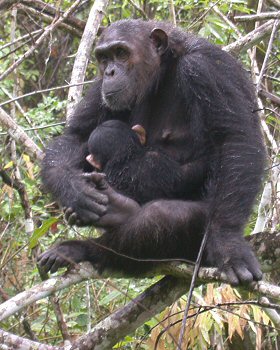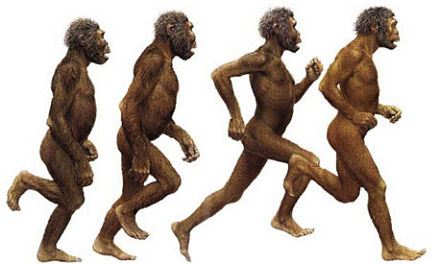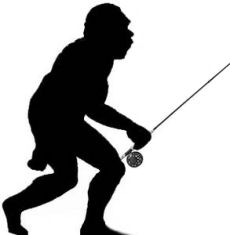
Detailed observations of chimpanzees indicate that upright walking may have emerged millions of years ago as an adaptation to be better able to carry scarce, high-quality foods and other resources. The new findings, in Current Biology, provide yet another hypothesis for the emergence of bipedalism, which other studies have linked to fighting ability, climate changeand food gathering.
In the latest research, Brian Richmond, of the George Washington University, and a team of scientists from the U.S., England, Japan and Portugal, investigated the behavior of modern-day chimpanzees as they competed for food resources.
The researchers allowed wild chimpanzees access to different combinations of two different types of nut – the oil palm nut, which is naturally widely available, and the coula nut, which is not. The chimpanzees’ behavior was monitored in three situations: (a) when only oil palm nuts were available, (b) when a small number of coula nuts was available, and (c) when coula nuts were the majority available resource.
When the rare coula nuts were available only in small numbers, the chimpanzees transported more at one time. Similarly, when coula nuts were the majority resource, the chimpanzees ignored the oil palm nuts altogether. The chimpanzees regarded the coula nuts as a more highly-prized resource and competed for them more intensely.
Co-researcher Kimberley Hockings, of Oxford Brookes University, undertook more observations on a different group of chimpanzees who were involved in crop-raiding, a situation in which they have to compete for rare and unpredictable resources. Here, 35 percent of the chimpanzees’ activity involved some sort of bipedal movement, and once again, this behavior appeared to be linked to a clear attempt to carry as much as possible at one time.
The findings suggest that chimpanzees switch to moving on two limbs instead of four in situations where they need to monopolize a resource, usually because it may not occur in plentiful supply in their habitat. Standing on two legs allows them to carry much more at one time because it frees up their hands. Over time, intense bursts of bipedal activity may have led to anatomical changes that in turn became the subject of natural selection where competition for food or other resources was strong.
“These chimpanzees provide a model of the ecological conditions under which our earliest ancestors might have begun walking on two legs,” said Richmond, an associate professor of anthropology. “Something as simple as carrying – an activity we engage in every day – may have, under the right conditions, led to upright walking and set our ancestors on a path apart from other apes that ultimately led to the origin of our kind.”
Related:
Discuss this article in our forum
Study Suggests Alligators Once Walked Erect
Chinese fossils may be new human species
Bashed-in prehistoric skull hints at the invention of violence
Did population density create modern humans?








Comments are closed.